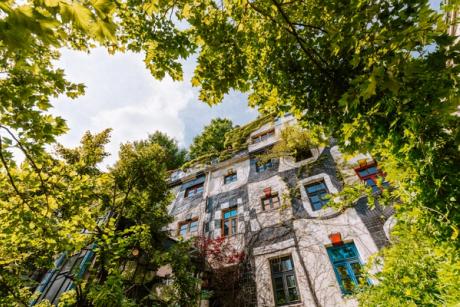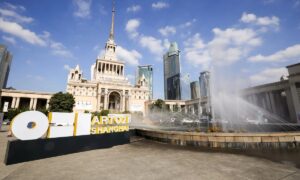
Does the art world really need another biennale, even one that claims to be putting climate change as its centre? Aren’t biennials supposed to be part of the problem rather than the solution? But the Klima Biennale, which bills itself as “the first ever climate-focused art festival in the world”, promises to be a biennial unlike any other. “With the vision and innovative power of art, the Klima Biennale Wien spurs the paradigm shift towards a liveable and sustainable future for our planet,” declares its ambitious mission statement. The organisers identify “participation, collaboration and awareness” as key tools in aiding them to fulfill this objective and issue the stirring clarion call that “we urgently need to find new ways of sharing knowledge and discussing strategies together!”So how is the Klima Biennale planning to make the climate crisis and species extinction “visible and tangible for everyone”? What gives me hope that its knowledge-sharing and strategy-discussing aspirations might actually achieve some genuine traction is the way in which Klima is making a point of foregrounding the local over the global, and encouraging collective and multidisciplinary action—combining art, design, architecture and science—across the Austrian capital. A major collaborationFor this biennial is predominantly a Vienna City initiative. Although its co-directors, photographer Claudius Schulze and cultural programmer Sithara Pathirana both cut their teeth organising the week-long ClimateArtFest in Hamburg in 2022, Klima marks a landmark collaboration between the city’s various Departments of Climate, Culture and Business. As such, it involves the integrated involvement of more than 60 municipal institutions, initiatives and organisations, along with the city’s major museums and galleries. That’s a first.It’s also a good sign that the main headquarters of the Biennale are in the KunstHausWein. Since it opened in 1991, this museum has made a point of combining art and ecology, and it is currently in the final stages of a major sustainable refurbishment. For Klima Biennale, KunstHausWein is becoming a veritable hub of sustainable activities, repair cafés and workshops as well as hosting a climate symposium and a major group exhibition Into the Woods. Here 16 artists, including Richard Mosse, Katie Paterson and Abel Rodríguez, an Amazonian plantsman- artist of the Nonuya people, have made work devoted to exploring issues around the plight of various forest ecosystems of the world, whether the Amazonian rainforest, the Embobut forest in Kenya, the primeval forests of the Carpathians, Swiss pine forests or Austria’s own woodlands.Elsewhere, the Biennale’s network of environmentally-conscious collaborations include the Vienna University of Technology developing a range of projects in spaces and public places throughout the Nordwestbahnof area with students from Vienna’s University of Applied Arts and the city’s Academy of Fine Arts. Grassroots activism and community actionThe Children’s Office of the University of Vienna is also developing events and activities geared towards engaging young people, while yet another key element of the Klima Bienniale is Immediate Matters, a special strand located throughout the entire fabric of the city in which radical local knowledge, grassroots activism and community action come together in a series of activities, exhibitions, performances and participatory art projects all of which engage with the challenges of the climate crisis. The Klima Bienniale’s multifaceted and locally embedded perspective was what especially appealed to Lucia Pietroiusti, the head of ecologies at London’s Serpentine Galleries, who is co-curating the Biennale’s other flagship exhibition Songs for the Changing Seasons. Indeed, Pietroiusti, who for the last decade has been a trailblazer in raising environmental awareness throughout the art world, feels that in the case of Klima, the term “biennale” is itself misleading. “I understand it to be a Vienna-wide festival that is very much focused on a local city-wide public and synchronised partnerships and connections between different organisations,” she says, adding that both she and her co-curator Filipa Ramos were keen to participate in Klima as “an experiment” in which a concern with climate, ecology and the environment permeates every element, “not only into theme and message but its philosophy and its fabric.” Pietroiusti and Ramos’s Songs for the Changing Seasons occupies the former station premises and surrounding area of the Nordwestbahnhof, with a multigenerational, international lineup of artists who each use various means to engage with different aspects and consequences of the environmental and ecological transformation that has already been brought about by climate change. They describe the show as offering “threshold spaces and spaces of transition” and which they say is concerned with “decentering the human from a much more entangled and non species-specific understanding of life on earth.”Visitors will be ushered in with “the siren call” of a sound piece by Sofia Jernberg, while the exhibition concludes with a giant 12m-long tapestry by Laure Prouvost that engages with the migration of birds. In between, there is an installation of Joan Jonas’s fish drawings made in response to the artist’s longstanding immersion in ocean ecologies; Adrián Villar Rojas’s first comic book; and an audio work by artist duo Cooking Sections, transmitted from a speaker rotating on a turntable the size of a salmon farm pen. While much of this work has a strikingly immersive impact, it is also nimble, easily transportable and sits lightly on the planet. Sometimes it vanishes altogether, as in the case of Chilean artist Natalia Montoya, who is collaborating with a local Viennese bakery to create edible human-shaped bread sculptures inspired by the Andean T’antawawa funerary tradition. There’s nothing new about the fact that we live in an interconnected, interdisciplinary world where the local and the global do not operate in isolation, and where homo sapiens needs to step away from taking centre stage on our planet—and fast. But the fact that the Klima Biennale seems to be genuinely taking these considerations to heart in its attempt to turn an entire city into a multifaceted collective platform to reflect on a more sustainable future has to be cause for optimism. Maybe this is one new biennial that the art world—and the world in general—actually does need.• Klima Biennale Wien, various venues throughout Vienna, 5 April-14 July; Into the Woods, KunstHausWien, 6 April-11 August


























